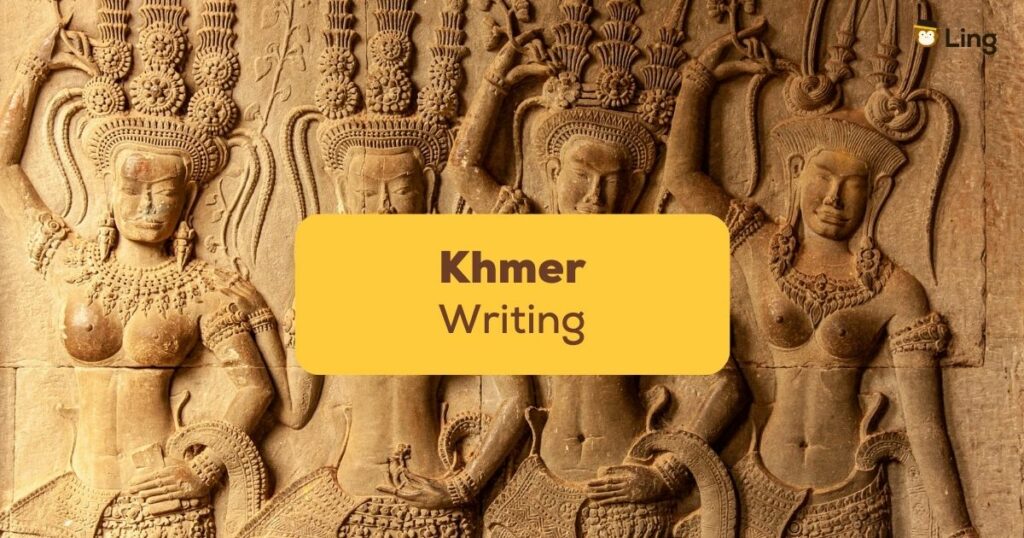Any neophyte to Khmer is bound to be a little intimidated by Khmer writing. All those swirls and squiggles may be daunting and bear absolutely no relationship whatsoever to the Latin alphabet most of us are familiar with, but will soon come to represent why Khmer is such a magical language to get to grips with.
With roots dating back over a millennium, Khmer writing is an embodiment of Cambodia’s historical, religious, and artistic evolution. This time, we’ll be exploring the fascinating world of Khmer ‘hieroglyphs’, exploring its history, characteristics, significance, and modern-day relevance.
Historical Evolution Of Khmer Writing
Written Khmer has a history that spans more than a thousand years. Its origins can be traced back to the 7th century when inscriptions on stone and metal were first carved in a script that would evolve into the modern Khmer language. The script is believed to have been influenced by various Indian scripts, particularly the Pallava script.
Over time, the Khmer alphabet underwent several transformations, adapting to Cambodia’s changing sociopolitical landscape and its interactions with neighboring cultures. As a member of the Mon Khmer languages, it is closely related to the tongues of its South East Asian neighbors Thailand and Myanmar. The script’s evolution can be broadly categorized into the following three periods.

Ancient Period (7th-13th Century)
This era saw the development of the Khmer script from its earliest forms into a more refined and recognizable version. Inscriptions on temple walls and religious artifacts reveal the script’s early use in religious contexts.
Angkor Period (9th-15th Century)
The Khmer Empire’s golden age marked a significant period for Khmer writing. The construction of monumental temples like Angkor Wat saw an increase in the use of the script in religious inscriptions, epics, and royal decrees.
Post-Angkor Period (16th Century To Present)
Following the decline of the Khmer Empire, Khmer writing continued to evolve under the influence of neighboring languages and cultures. Modern Khmer script, as we know it today, began to take shape during this time.
Characteristics Of Khmer Writing
The Khmer syllabic alphabet includes symbols for 33 consonants, 24 dependent vowels, 12 independent vowels, and a number of diacritic symbols as well as traditional Khmer punctuation marks. Let’s look at some key characteristics of the Khmer script below.
Curvaceous Aesthetics
One of the most striking features of Khmer writing is its fluid and curvaceous appearance. The characters often possess graceful curves and intricate loops, giving the script an artistic and ornamental quality.
Complex Diacritics
The consonant’s inherent vowel sounds can be modified using diacritical marks, which are placed above, below, in front of, or behind the base characters. This complexity allows for a wide range of inherent or dependent vowel sounds to be accurately represented.
Consonant Stacking
Khmer script allows for the stacking of consonants on top of each other, resulting in visually intriguing combinations that can sometimes resemble intricate patterns.
Varied Ligatures
Ligatures, where two or more characters are combined into a single unit, are common in Khmer writing. This adds to the uniqueness of the script and its visual appeal.

Significance And Cultural Implications
The Cambodian language goes beyond being just a means of communication; as the official language, it’s a representation of Cambodia’s cultural and spiritual heritage. It has played a crucial role in preserving the country’s history, literature, and religious traditions. Some notable aspects of Khmer writing’s significance include:
Religious Expression
Khmer writing is intricately linked to Buddhism, the predominant religion in Cambodia. Temples like Angkor Wat are adorned with inscriptions that convey religious teachings, stories, and dedications.
Literary Treasures
The script has been instrumental in preserving Cambodia’s literary heritage. Epic poems, folktales, and historical accounts have been passed down through generations in written form of the Mon Khmer language.
Ceremonial Usage
From formal documents to auspicious occasions, Khmer writing is an integral part of ceremonies, weddings, and official events. Its presence adds a touch of elegance and tradition to these occasions.

Modern-Day Relevance And Challenges
While the spoken language and Khmer writing hold a strong place in Cambodia’s history, its relevance in the modern world remains significant. Efforts are being made to ensure that the script continues to thrive amidst the challenges posed by digital technology and changing linguistic landscapes.
Digital Age Adaptation
In the digital era, Khmer writing has faced challenges in terms of digitization and standardization for online platforms. However, technology has also enabled the creation of digital fonts and tools that allow the script to be used in digital contexts.
Education And Preservation
Initiatives to teach Khmer writing in schools and universities are essential to ensure its survival. Additionally, efforts are being made to document and preserve ancient inscriptions and manuscripts for future generations.
Cultural Awareness
Encouraging cultural awareness and appreciation of Khmer writing among younger generations fosters a sense of pride and ownership over the script’s legacy.
As Cambodia moves forward, embracing its heritage and preserving the beauty of its script remains crucial, ensuring that Khmer writing’s story continues to be written for generations to come.
Some Khmer Writing Vocab To Practice
| English | Khmer | Pronunciation |
|---|---|---|
| Alphabet | អក្សរខ្មែរ | Akhsar Khmer |
| Script | អក្សរ | Akhsar |
| Consonant | ត្រីកោណ | Trikaon |
| Vowel | អក្សរដៃត្រី | Akhsar Daitri |
| Diacritic | សញ្ញា | Sonnha |
| Glyph | និច្ច | Nich |
| Ligature | ខុនបូតូ | Khon Botu |
| Syllable | អត្រា | Atrar |
| Word | ពាក្យ | Pake |
| Sentence | បន្ទាត់ | Bantat |
| Punctuation | សញ្ញាក្រម | Sonnha Kram |
| Calligraphy | អក្សរចរណ៍ | Akhsar Chroeng |
| Manuscript | សៀវភៅដែលកំណត់ | Svep Dai Kamnot |
| Inscription | អត្ថបទការបញ្ជាក | Atthabat Ka Bangchak |
| Pen | សម្លាប់ | Samleb |
| Ink | គ្រឿងសម្លាប់ | Krueang Samleb |
| Scroll | សំបុកច្រើន | Sambok Chrern |
| Stone Carving | ការតុកតារាប្លូ | Ka Taok Ta Rakblu |
| Scribe | អ្នកសរសេរ | Nak Sorserech |
| Grammar | វចនានុក្រក | Vichhyanukorak |
Learn More Magical Khmer With Ling
Being able to read and write Khmer is essential to becoming fluent in this fantastic language. With Ling app’s finger tracing tool, you will start to untangle the complex patterns in no time. Give the Ling a go today by clicking on Google Play or the App Store and begin your Cambodian adventure today!



































































